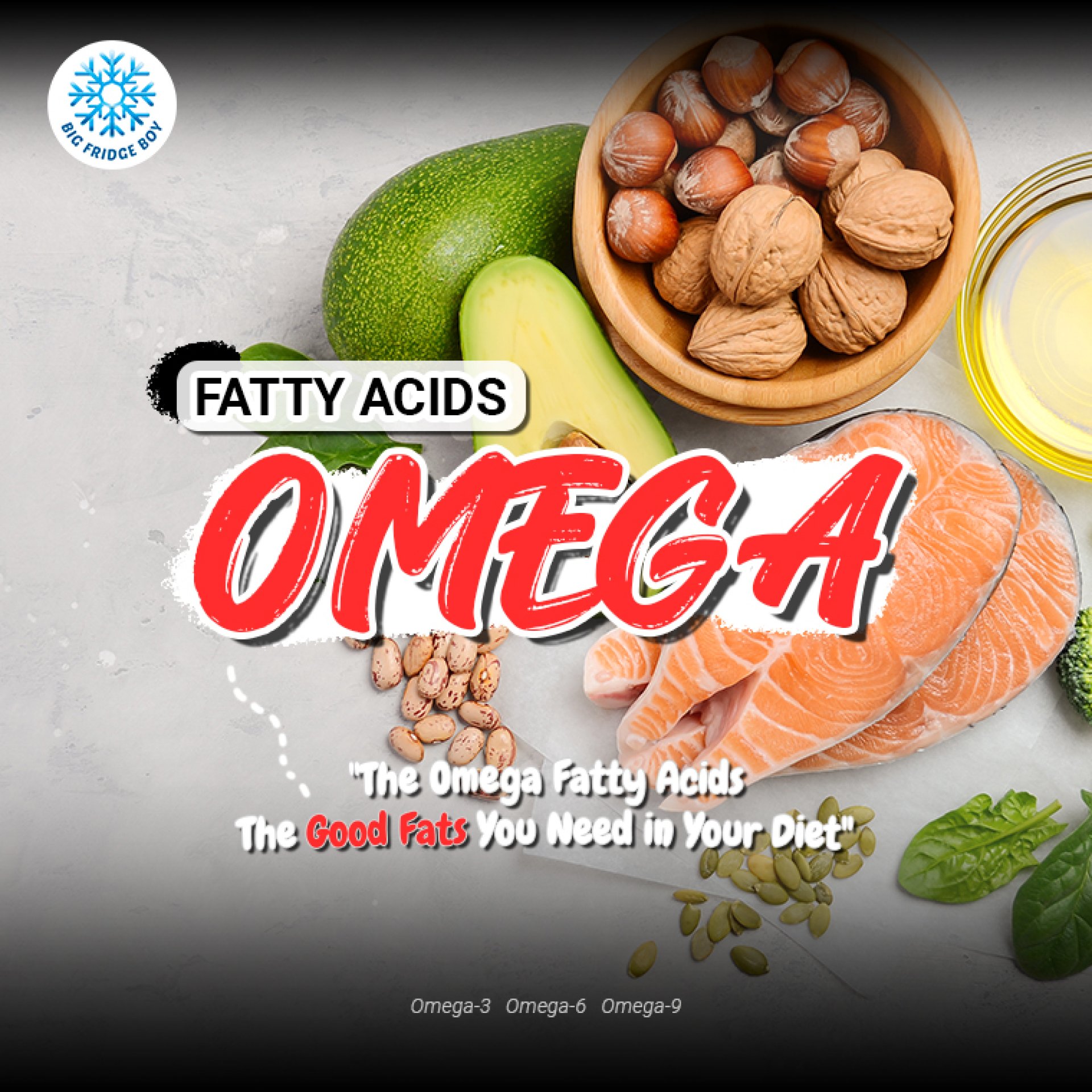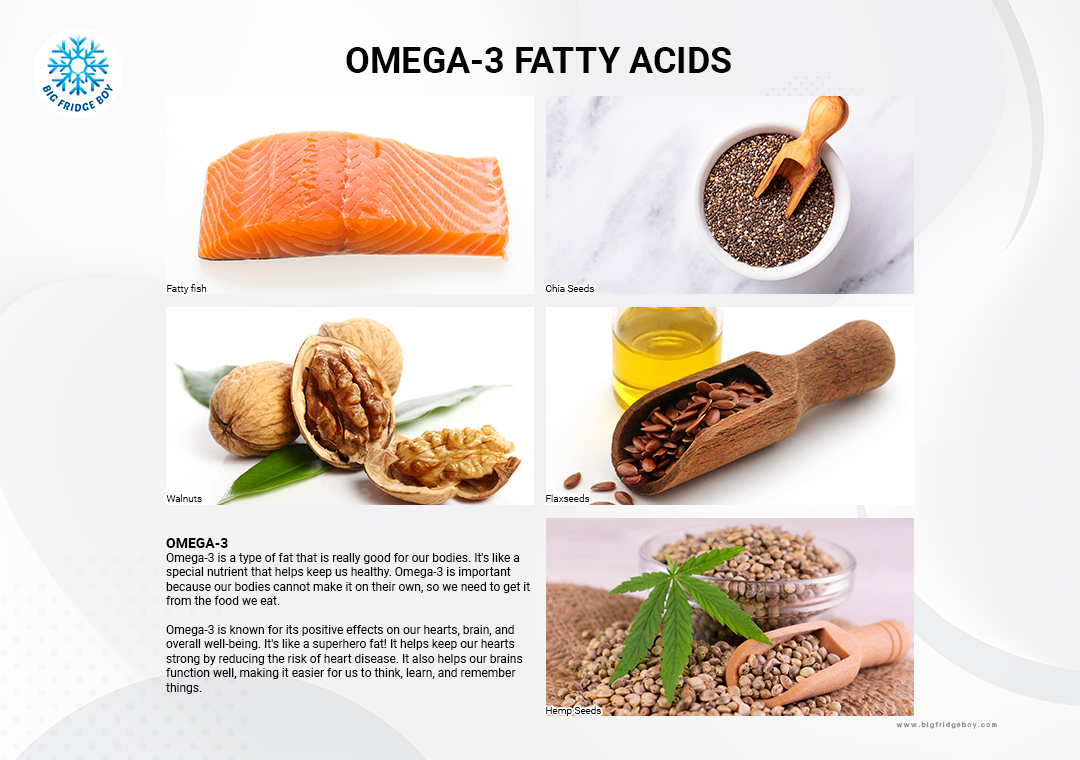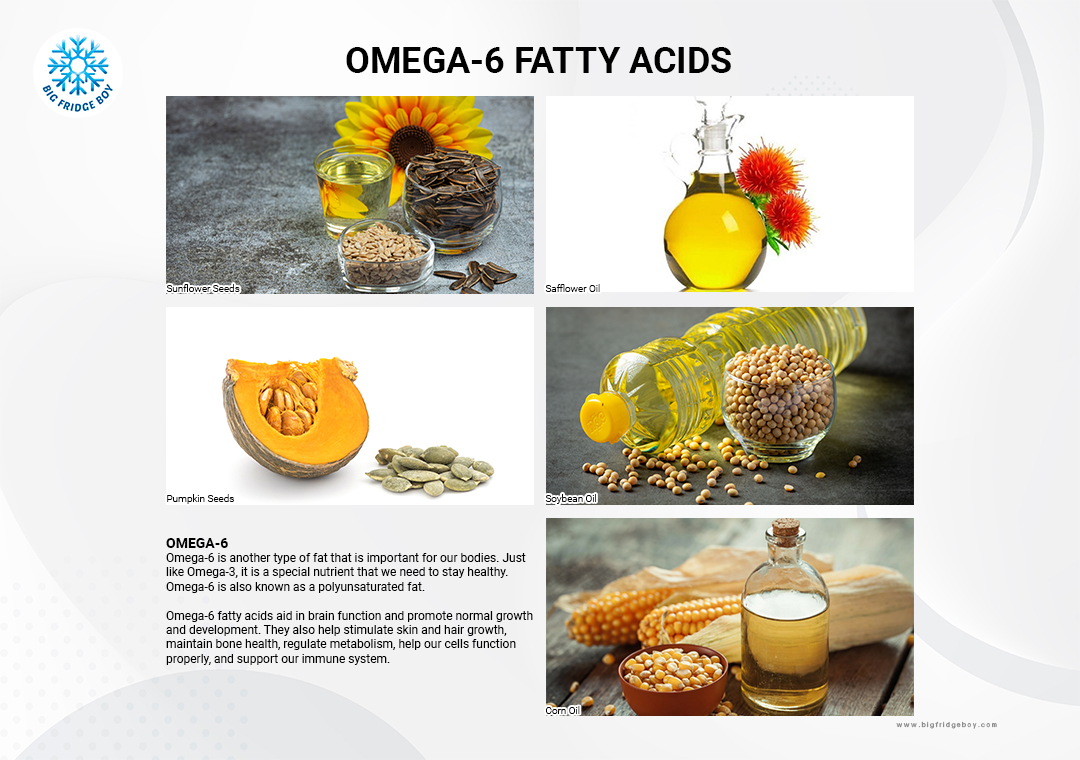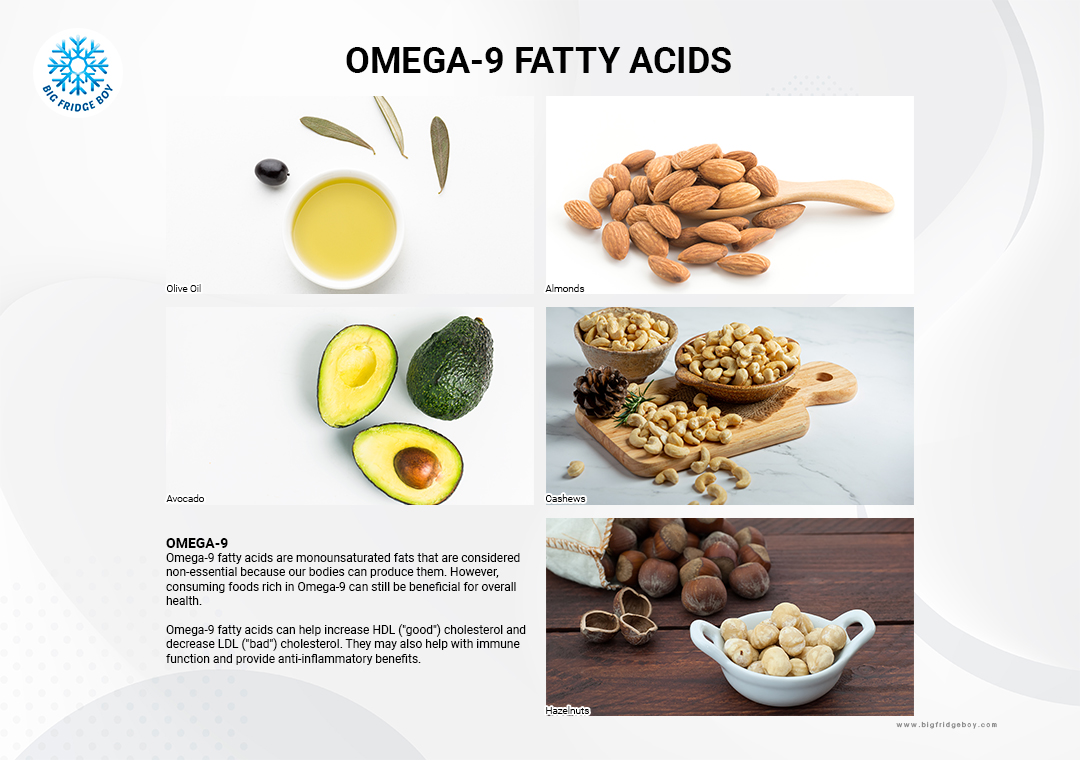Are You Missing Out on Omega Fatty Acids? Here's Why It Matters

Omega fatty acids are a group of polyunsaturated fatty acids that are vital for human health. They are considered "essential" because our bodies cannot produce them on their own, so they must be obtained from our diet. There are three types of omega fatty acids: omega-3, omega-6, and omega-9.

Omega-3 Fatty Acids
Omega-3 is a type of fat that is really good for our bodies. It's like a special nutrient that helps keep us healthy. Omega-3 is important because our bodies cannot make it on their own, so we need to get it from the food we eat.
Omega-3 is known for its positive effects on our hearts, brain, and overall well-being. It's like a superhero fat! It helps keep our hearts strong by reducing the risk of heart disease. It also helps our brains function well, making it easier for us to think, learn, and remember things.
Sources
When it comes to sources of Omega-3 fatty acids, fish and certain plant-based foods are known to be rich in these essential fats. Here are five top sources that contain high levels of Omega-3.
- Fish (especially fatty fish)
Fatty fish such as salmon, mackerel, sardines, trout, and tuna are excellent sources of Omega-3 fatty acids. They are rich in two types of Omega-3s: eicosapentaenoic acid (EPA) and docosahexaenoic acid (DHA).
Fatty fish can provide around 1,000-2,500 milligrams of combined EPA and DHA per 100 grams (3.5 ounces). - Chia Seeds
Chia seeds are tiny black seeds that are packed with Omega-3 fatty acids, specifically alpha-linolenic acid (ALA). They are also a good source of fiber and other nutrients. Adding chia seeds to your meals, smoothies, or yogurt can boost your Omega-3 intake.
Chia seeds typically contain around 4,500-5,000 milligrams of ALA per 28 grams (1 ounce). - Flaxseeds
Flaxseeds are another plant-based source of Omega-3 fatty acids, primarily ALA. These seeds can be ground and added to cereals, baked goods, or smoothies. Remember to grind them before consuming them to enhance their digestibility and nutrient absorption.
Flaxseeds typically provide around 6,000-6,500 milligrams of ALA per 28 grams (1 ounce). - Walnuts
Walnuts are tree nuts that are high in Omega-3 fatty acids, mainly ALA. They also offer other beneficial nutrients and antioxidants. Adding a handful of walnuts to your diet can provide you with a good dose of Omega-3s.
Walnuts generally provide around 2,500-3,000 milligrams of ALA per 28 grams (1 ounce). - Hemp Seeds
Hemp seeds are derived from the Cannabis sativa plant and are rich in Omega-3 fatty acids, including ALA. They also provide a good amount of protein and minerals. Hemp seeds can be sprinkled over salads, added to smoothies, or used in baking.
Hemp seeds typically contain around 2,000-2,500 milligrams of ALA per 28 grams (1 ounce).
Types
The three main types are alpha-linolenic acid (ALA), eicosapentaenoic acid (EPA), and docosahexaenoic acid (DHA). ALA is found in plant sources and needs to be converted into EPA or DHA in the body to be utilized effectively.
- Alpha-linolenic acid (ALA)
This short-chain omega-3 fatty acid serves as a source of energy and can also be converted into the long-chain omega-3 fatty acids EPA and DHA. ALA is found in plant-based foods like flaxseeds, chia seeds, walnuts, and certain types of oils like flaxseed oil and canola oil. - Eicosapentaenoic acid (EPA) and Docosahexaenoic acid (DHA)
These are long-chain omega-3 fatty acids that are more readily used by the body. They play crucial roles in many physiological functions. EPA benefits heart health and immune response, while DHA is important for brain health and vision. EPA and DHA are primarily found in fatty fish like salmon, mackerel, tuna, and sardines, as well as in fish oil supplements.
However, the body's conversion of ALA into EPA and DHA is not very efficient. Only a small percentage (usually less than 10%) of the ALA we consume is converted into EPA and DHA. This is why it's often recommended to consume foods rich in EPA and DHA directly, especially if you're following a vegetarian or vegan diet that excludes fish.
In summary, while ALA, EPA, and DHA are all types of omega-3 fatty acids, they are not equally utilized in the body. Consuming a balance of these through a variety of food sources or through supplements (if needed) can help ensure your body gets the omega-3s it needs for optimal health.

Omega-6 Fatty Acids
Omega-6 is another type of fat that is important for our bodies. Just like Omega-3, it is a special nutrient that we need to stay healthy. Omega-6 is also known as a polyunsaturated fat.
Omega-6 fatty acids aid in brain function and promote normal growth and development. They also help stimulate skin and hair growth, maintain bone health, regulate metabolism, help our cells function properly, and support our immune system.
Sources
Here are five top sources that contain high levels of Omega-6.
- Safflower Oil
Safflower oil is one of the richest sources of Omega-6 fatty acids. It has a high smoke point, making it suitable for cooking at higher temperatures. However, it's important to use safflower oil in moderation as excessive intake of Omega-6 fatty acids relative to Omega-3s may disrupt the balance.
Safflower oil typically contains approximately 10-13 grams of Omega-6 per tablespoon (15 milliliters). - Sunflower Seeds
Sunflower seeds are a nutritious snack that contains a significant amount of Omega-6 fatty acids. They are also rich in other beneficial nutrients like vitamin E and magnesium. Enjoy them as a snack or sprinkle them on salads and other dishes.
Sunflower seeds typically contain around 9-11 grams of Omega-6 per 28 grams (1 ounce). - Soybean Oil
Soybean oil is widely used in cooking and food preparation. It is a good source of Omega-6 fatty acids. However, similar to safflower oil, it's important to consume soybean oil in moderation to maintain a healthy Omega-6 to Omega-3 ratio.
Soybean oil typically provides around 7-9 grams of Omega-6 per tablespoon (15 milliliters). - Corn Oil
Corn oil is another common cooking oil that contains Omega-6 fatty acids. It is commonly used in frying and baking. As with other sources of Omega-6, it's essential to balance its consumption with adequate intake of Omega-3s.
Corn oil typically contains approximately 8-10 grams of Omega-6 per tablespoon (15 milliliters). - Pumpkin Seeds
Pumpkin seeds are not only a tasty snack but also a source of Omega-6 fatty acids. They are packed with other nutrients like magnesium, zinc, and iron. Enjoy them roasted or add them to salads for an extra crunch.
Pumpkin seeds typically contain around 5-7 grams of Omega-6 per 28 grams (1 ounce).
Balance with Omega-3s
Omega-6 fatty acids are essential fats that are important for our health, but it's crucial to maintain a proper balance between Omega-6 and Omega-3 fatty acids in our diet.
When the balance of these two types of fatty acids is off - specifically, when there is an excess of omega-6 fatty acids relative to omega-3 fatty acids - it can contribute to an overactive immune response. This can lead to chronic inflammation, a state where the immune system is constantly active, causing damage to healthy cells and tissues over time.
Chronic inflammation has been linked to many health problems, including heart disease, cancer, metabolic syndrome, diabetes, and Alzheimer's disease. This is why maintaining a balance of omega-3 and omega-6 fatty acids in the diet is important for health. Most health professionals recommend a dietary ratio closer to 4:1 (omega-6 to omega-3).

Omega-9 Fatty Acids
Omega-9 fatty acids are monounsaturated fats that are considered non-essential because our bodies can produce them. However, consuming foods rich in Omega-9 can still be beneficial for overall health.
Omega-9 fatty acids can help increase HDL ("good") cholesterol and decrease LDL ("bad") cholesterol. They may also help with immune function and provide anti-inflammatory benefits.
Sources
Omega-9 fatty acids are not measured in the same way as Omega-3 and Omega-6 fatty acids. Omega-9 fatty acids are not typically provided on nutrition labels.
- Olive Oil
Olive oil is a well-known source of monounsaturated fats, including Omega-9. Extra virgin olive oil is particularly rich in beneficial compounds and is commonly used in cooking, dressings, and dips. - Avocado
Avocado is a fruit that is not only delicious but also a great source of Omega-9 fatty acids. It's also packed with other nutrients like fiber, potassium, and vitamins. - Almonds
Almonds are a nutrient-dense nut that contains monounsaturated fats, including Omega-9. They are also a good source of protein, fiber, and various minerals. Enjoy them as a snack or incorporate them into your meals and desserts. - Cashews
Cashews are another nut that provides a good amount of Omega-9 fatty acids. They are also rich in minerals like magnesium and zinc, making them a healthy addition to your diet. - Hazelnuts
Hazelnuts are not only delicious but also a good source of Omega-9 fatty acids. They are packed with beneficial nutrients and antioxidants, making them a nutritious choice for snacking or adding to your recipes.
Daily Intake Recommendations
The daily intake recommendations for omega fatty acids can depend on a variety of factors including age, sex, and overall health.
- Omega-3 Fatty Acids
Adults (both men and women)
Aim for at least 250-500 mg combined EPA and DHA each day for general health. This is equivalent to at least two servings of fatty fish (such as salmon, mackerel, herring, or sardines) per week.
Pregnant and breastfeeding women
Aim for at least 300 mg DHA per day. - Omega-6 Fatty Acids
There isn't a set standard for omega-6 fatty acid intake. However, in the context of a balanced diet, the American Heart Association recommends that the majority of your fat intake, around 15-20% of total calories, come from unsaturated fats, which include omega-6 fatty acids. - Omega-9 Fatty Acids
Omega-9 fatty acids are not considered essential because your body can produce them, so there isn't a specific daily recommendation for them. Nonetheless, foods rich in omega-9 fats, like olive oil, almonds, and avocados, are part of a healthy diet and should be included regularly.
Remember, while omega fatty acids have potential health benefits, they should be consumed as part of a balanced, nutrient-rich diet, and not in isolation or excessive amounts because it can cause inflammation and keep exercising for maximum efficiency.






